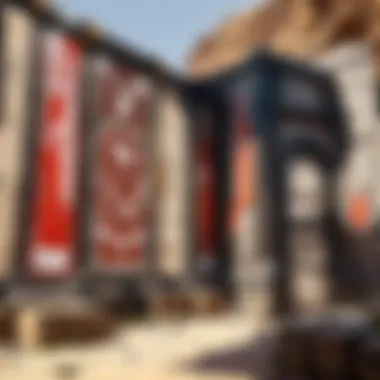The Standing Wall: Exploring Its Multifaceted Impact


Intro
The exploration of the standing wall extends beyond mere structural integrity. This concept resonates deeply within various domains, especially in architecture and gaming, most notably in tactical titles like APEX Legends. This article aims to unveil the layers of the standing wall, its strategic significance in gameplay, artistic value in design, and its historical context.
Through a detailed analysis, we will investigate the ways in which the standing wall can serve both a practical role and a metaphorical significance. From obstacles in urban planning to protective shields in the midst of battle, understanding the diverse roles of the standing wall equips gamers and architects alike with insights into the strategic and aesthetic elements influencing their respective fields.
Game Updates and Patch Notes
As the gaming landscape continually evolves, APEX Legends receives regular updates that reshape gameplay dynamics. This ongoing development impacts the utility of standing walls in various environments. Staying abreast of these updates allows players to adapt strategies and exploit new advantages in their gameplay.
Summary of Recent Game Updates
- Season 15 introduced new character abilities that interact uniquely with environment structures, emphasizing walls.
- The map changes in Storm Point have added new standing walls that offer additional cover in crucial battle zones.
Detailed Breakdown of Patch Notes and Changes
Recent patches have focused on enhancing the interaction between characters and standing structures.
- Pathfinder's Grapple Update: Adjustment allows for smoother transitions onto standing walls, improving strategic positioning.
- Cover Mechanics: Introduction of destructible standing walls in specific locations offers new tactical depths and gameplay interactions.
Character Guides
Understanding characters’ interactions with walls is vital for effective play. Different legends utilize these structures to varying degrees.
Overview of Character Abilities and Playstyle
Some champions thrive in tight spaces, taking advantage of standing walls for cover or escape. For example, Gibraltar’s Dome of Protection creates an effective standing wall that shields teammates while allowing for strategic plays.
Tips and Strategies for Mastering Each Character
- Wraith: Use phase shifts to maneuver around walls, quickly repositioning for unexpected combat advantages.
- Revenant: Utilize his silence ability near standing walls to suppress enemy abilities, controlling the fight's tempo while keeping behind cover.
Weapon Analysis and Loadout Suggestions
Weapon selection heavily influences how players utilize the standing wall in APEX Legends. Different weapons complement distinct strategies related to these structures.
Analysis of Weapon Stats and Effectiveness
- Longbow DMR: Excellent performance while taking cover behind standing walls, allowing for strategic advantage against opponents aiming from afar.
- R-99 SMG: Effective in close quarters, ensuring quick damage output while positioned near walls for cover.
Recommended Weapon Loadouts for Different Playstyles
- Defensive Players: Select heavier weapons, such as the Devotion LMG, best used behind walls to provide suppressing fire.
- Aggressive Players: Light weapons like the R-301 Carbine, enabling quick rushes around standing walls during flank engagements.
Game Strategies and Tips
A deeper understanding of the standing wall enhances creativity and tactical acumen within various game scenarios.
Strategies for Different Game Modes and Scenarios
- In Battle Royale, always be aware of wall locations to set ambushes or dodge encounters. Use walls to break line-of-sight effectively.
- In control modes, standing walls can dictate territory ownership and give clear signs of where to establish defenses.
Tips for Improving Gameplay Mechanics and Decision-Making
- Anticipate wall placements in the map design for strategic rotations. Each game usually has zones governed by specific layout patterns.
- Practice angles and cover provided by walls to optimize aiming and reduce exposure when scanning for enemies.
The standing wall is not just a physical obstruction; it is a vital component shaping gameplay in APEX Legends. Its strategic use can make the difference between victory and defeat.
In understanding the multifaceted nature of the standing wall, whether it be in the immersive realm of gaming or the structural design of urban environments, players can harness its full potential. This discussion encourages both creative and strategic thought in various applications, enriching the overall gaming experience.


Understanding the Standing Wall
The standing wall is a significant element in multiple contexts, particularly in architecture and gaming. It serves practical purposes, facilitating both structural support in buildings and strategic positioning in battle arenas. Understanding this concept becomes essential for players in APEX Legends and individuals involved in architectural design. With a nuanced comprehension, architects can make informed decisions that balance aesthetics with functional requirements. Meanwhile, players can optimize their gameplay tactics by strategically utilizing standing walls to their advantage.
Definition of the Standing Wall
A standing wall is often characterized as a vertical structure that resists lateral forces and stands independently. It can be made of various materials such as timber, stone, or modern composites. In buildings, standing walls hold the weight of ceilings or roofs above them and maintain drainage of downpoured water at the sides. This static role is contrasted with "moveable walls" that frequently change their placement or function. In APEX Legends, the definition adapits further; the standing wall signifies not only a physical barrier but also a protective cover that evolves with the gameplay dynamics.
Historical Context
The construction and use of standing walls stretches back to ancient civilizations. Initially, these walls were designed for protection. Early walls gave safety from invading forces, illustrating their crucial role in society's defense mechanisms. Over time, architectural advancements enabled the development of more complex wall structures.
In modern architecture, the emphasis has shifted to integrating standing walls into both residential and commercial designs. The rise of high-challenge gaming, namely APEX Legends, has also contributed to reinterpreting standing walls as interactive volumes. The juxtaposition of historical data with contemporary use is crucial for understanding the totality of the standing wall's importance. By examining its evolution, one cultivates awareness of current implications in both real life and virtual environments.
Standing Wall in Architecture
The standing wall plays a crucial role in architecture, acting as a fundamental component that supports both functional and aesthetic objectives. It is not merely a barrier but serves a multitude of purposes, shaping spaces and influencing the behavior of those who inhabit them. By understanding the significance of the standing wall in architectural terms, one can grasp how structural design and visual impact intertwine.
Structural Integrity
Structural integrity is paramount in the design of any building, and standing walls are a significant aspect of this principle. These walls bear the weight of roofs and upper floors while resisting forces such as wind and seismic activity. Engineers meticulously calculate materials, load distribution, and wall placements to ensure that buildings withstand time and environmental stressors.
Well-designed standing walls ideally include materials like reinforced concrete or steel, combining strength with durability. The thickness and reinforcements of these walls can significantly affect the overall stability of a structure, ensuring it remains resilient over decades. When architect planning is sound, these walls contribute not just to safety but also enhance the building's longevity.
"A structurally sound standing wall can mean the difference between a safe space and a potential hazard."
Aesthetic Considerations
In addition to structural considerations, the aesthetic contributions of standing walls are conspicuous in architecture. They can dictate the visual flow and create unique spatial experiences. Effective use of colors, textures, and designs can transform mundane barriers into focal points. For instance, a beautifully designed standing wall can enhance the character of a building, providing visual harmony with its environment.
The choices of materials and patterns are also vital. Glass walls might bring transparency, allowing natural light to flood the space, while stone or brick can introduce warmth and permanence. Ultimately, standing walls influence not only the interior climate but also provide an identity to structures in a landscape. Choices about standing walls can translate design intent into a tangible experience, marrying form with function.
If considered properly, standing walls amalgamate the critical aspects of architecture—supporting safety while simultaneously enriching visual aesthetics. Their impact is felt in both the tangible and intangible attributes of built environments.
Standing Wall in APEX Legends
The standing wall plays a crucial role in APEX Legends gameplay, significantly affecting combat strategies and player interactions. Its utility extends beyond mere cover; it offers tactical maneuvering possibilities for players of all skill levels. Understanding its multifaceted purpose can be the difference between life and elimination in the fast-paced arena.
Strategic Advantages
In the world of APEX Legends, choosing the right moment to utilize a standing wall can enhance strategic footholds during engagements. Here are the key advantages it offers:
- Block Enemy Sightlines: Standing walls obstruct visibility, allowing players to evade enemy radar and regroup.
- Control Combat Scenarios: By positioning behind a standing wall, players can better manage the flow of conflict, either pushing forward with an ambush or retreating when necessary.
- Encouragement of Creative Plays: The standing wall invites innovation and thoughtful maneuvers; players can engage from behind cover or use it to create angles that confuse opponents.
For serious gamers, mastering how and when to use standing walls is an essential skill. Balancing aggression and defense contributes immensely to overall team performance.
Cover and Protection
Cover provided by standing walls is integral for player survival. Here’s how it enhances protection:
- Physical Shielding: Like barriers in architecture, standing walls can obstruct incoming fire. Positioning oneself correctly minimizes the chance of taking damage.
- Support Team Dynamics: During team fights, staying behind a standing wall can help protect teammates when healing or strategizing. Communication and repositioning around these elements often lead to successful engagements.
- Dynamic Utility: The adaptability of standing walls allows players to modify their defensive strategy as the situation evolves. For example, using explosives around a standing wall can turn it from a mere protective measure into a lethal obstacle for foes.
In summary, the features of standing walls transform defensive play styles in APEX Legends, empowering players to enhance their gameplay and inspire innovative tactics. Players who master these techniques can develop a better grasp of situational awareness and support their teams more effectively.
Psychological Impact of the Standing Wall
In exploring the standing wall, it is crucial to consider its psychological implications. The presence of a wall in any setting invokes a range of emotional and cognitive responses from those who interact with it. For players in APEX Legends, understanding these responses can enhance both individual gameplay strategies and team dynamics.
Perception of Space


The perception of space is closely tied to how a standing wall shapes one’s experience in an environment. In gaming, walls serve to create boundaries, consequently affecting the players' sense of spatial awareness. When players encounter a standing wall, they instinctively gauge their position relative to it. For instance, players may feel more secure while covered by a wall in a confrontational situation or apprehensive if they have limited options for movement.
Moreover, consider how walls influence sound and visibility. A thick wall might mute incoming sounds, contributing to a sensation of isolation, while thin walls allow sound to travel, inducing feelings of vulnerability. Understanding these aspects may affect how players choose where to take cover or engagements with opponents. This highlights the strategic nature of walls in gameplay, as positioning relative to a wall can alter not just the safety but also the confidence with which players approach various situations.
Influence on Gameplay
The influence of standing walls on gameplay cannot be overstated. These barriers fundamentally alter perceived gameplay dynamics, allowing for an assortment of tactical opportunities. Defensively, standing walls provide necessary cover, allowing players to plan their next move or to ambush opponents. Strategically placed walls often lead to emergent gameplay phenomena, such as high-stakes confrontations where instinct may take over.
An additional layer is added through the interactive elements of standing walls in APEX Legends. Players often rely on walls to disrupt line of sight, forcing opponents to rethink their attack plan. A player can reset engagements by using walls to maneuver, regaining the upper hand. Furthermore, standing walls necessitate awareness from all players, often conditioning their approach depending on the environment around them.
Comparative Analysis
The section on comparative analysis is crucial in examining the standing wall across various contexts. This analysis explores differences, benefits, and unique considerations. Specifically, it highlights how standing walls interact with other barriers in both architecture and gameplay. Understanding these distinctions can provide insights into their effectiveness and applications. A nuanced approach helps players and designers alike optimize their strategies and designs.
Standing Walls vs Other Barriers
Standing walls serve a unique purpose when compared to other barriers, displaying distinct characteristics in various settings. In Architecture, these walls represent both a physical structure and an aesthetic element. They support roofs and withstand loads while contributing to a building's overall design. In contrast, barriers like fences or partitions may not provide the same structural strength or visual impact.
In gaming, particularly in APEX Legends, standing walls become dynamic elements in the gameplay arena. They offer cover and a sense of enclosure, which differs from simplistic barriers like walls of cardboard or temporary shields that players might use. This comparison allows players to assess their strategic options:
- Standing Walls: Provide reliable protection and are typically constructed for durability. They enhance player strategy, creating opportunities for tactical advantages.
- Temporary Barriers: Often lack stability, making them less effective in intense engagements.
Recognizing these variances enhances decision-making. Players who understand the capabilities of standing walls can react smarter and apply their skills more efficiently.
Cultural Variations
The perception and utilization of standing walls can also differ by culture. In some societies, walls symbolize power and security. In others, they serve to delineate space without barriers—creating a community atmosphere.
In APEX Legends, these cultural variations manifest in how game spaces are designed and how gameplay is affected by the world around characters.
- As UrbanDefenses: Cities with robust standing walls may reflect strong architectural heritages, whereas less fortified places indicate resilience.
- In Gameplay Experience: Different maps might utilize standing walls varying with landscape designs reflecting the nuances of culture. Some might emphasize open spaces while others are dense with fortifications.
Understanding cultural implications allows players and designers to enrich their interpretative frameworks and tap better into the immersive experience gameplay offers. Engaging with these elements adds depth to player strategy and enhances cultural appreciation within gaming.
Through comparative analysis, both in architecture and gameplay, we can build a solid foundation that enables players to leverage standing walls to their full potential.
Building Effective Standing Walls in APEX Legends
Building effective standing walls in APEX Legends is crucial for gaining a tactical advantage in the game. Players who understand how to position walls strategically can maximize their protection from enemy fire while also enhancing their team's efficiency during engagements. Essentially, standing walls not only provide physical barricades but can also shape playstyles and alter team dynamics in relevant combat situations.
Choosing the Right Location
Location is perhaps the first key consideration when building standing walls. The placement can determine whether or not the walls can be effectively utilized. Opting for areas with high ground can generally offer better cover as players can command a superior vantage point. Additionally, spotting locations near choke points or entry routes enhances the barrier's defensive capabilities.
When surveying a map, observe the following:
- Visibility and Terrain: Ensure that the chosen spot minimizes visibility from multiple angles while adapting to the natural layout of the terrain. This reduces the risk of being flanked by enemy players.
- Team Coordination: The positioning should allow teammates to move around the walls freely while still gaining protection. Close communication about the wall's intention can make a tactical difference.
- Dynamic Situations: Evaluating how quickly players can change the wall's position or reinforce it when necessary makes the approach more adaptable under pressure. It is recommended to practice dropping walls in tendencies of different maps, as each environment offers distinct avenues of resistance where standing walls can be more efficient.
Recognizing location advantages translates to dominion in firefights.
Timing and Execution
The effectiveness of standing walls hinges on when and how they are deployed. Understanding the flow of battle is essential, impacting other players’ perceptions and aggression in firefights. Moments of high tension often call for immediate responses, hence, effective execution relies substantially on timing. Here’s what players should keep in mind:
- Immediate Use: If incoming fire is detected, players must act quickly to deploy standing walls instead of waiting until they are scattered. An overwhelming disadvantage may arise on the field, so preemptive strategies could save critical lives.
- Synchronized with Other Abilities: Aligning wall drops with the skills of Legends like Gibraltar, whose protective dome activates additional cover, can form a combined barrier that proves difficult for opponents to breach.
- Predictive Response: Veteran players often gauge where engagement will happen based on ally movements or enemy sounds. Deploying walls where anticipated fire may originate allows teams to take the fight on their own terms.
Those players who learn to fuse timing with execution multiply their combat potential.
Effective wall strategies in APEX Legends underscore the importance of constant awareness and adaptability to changing battlefield scenarios.


This coordination of placement and execution logically follows that mastering standing walls not only impacts direct combat engagements but encourages teamwork and enhances overall gameplay longevity.
Technological Advances Impacting Standing Walls
The dynamic landscape of both architecture and gaming is being reshaped rapidly by technological advances. In the context of standing walls, these advancements flash through innovations that enhance construction techniques, user experience, and gameplay mechanics. The merging of virtual expertise with physical models creates a continuum that fosters more strategic designs, impacting not only how structures are built but also how players interact with environments. When examining the importance of these advances, it becomes clear they redefine robustness, adaptability, and user engagement.
Game Development Innovations
Within the realm of APEX Legends, game development innovations contribute significantly to the role of standing walls in gameplay. Precise physics engines allow these walls to behave realistically, giving players tangible cover as they navigate combat scenarios. Furthermore, the incorporation of dynamic environments means that players must continuously adapt to the shifting conditions caused by rival activities or environmental changes.
This interactivity offers multiple tactical possibilities:
- Cover Dynamics: Players rely on standing walls for cover. A wall's physical structure can absorb bullets or potential damage, giving users critical time to strategize.
- Map Integration: Innovative placement of standing walls is conducive to enhancing map strategies. Developers can position obstacles to encourage varied routes and player interactions.
- Responsive Gameplay: Building mechanics enable players not only to hide behind standing walls but also to create them. This flexibility introduces fresh gameplay scenarios, making standing walls integral to game strategy rather than placement backdrops.
Virtual vs Physical Interpretations
The differentiation between virtual and physical interpretations of standing walls bears weight for both live architectural endeavors and digital gameplay. In the real world, the advancements in materials science translate to the ability to produce walls that are both stronger and lighter. These interpretational differences shape understanding.
In video games:
- Visual Realism: Techniques such as photogrammetry and realistic lighting contribute significantly to the perception of standing walls, giving them substance and reality.
- Functional Logic: Digital representation often allows for mechanics that living structures simply cannot accommodate, such as quick deployment and spontaneous redesign during battles.
Consider the psychological effects of encountering a virtual wall in APEX Legends. The visual feast adds a layer of involvement, far beyond mere survival tactics. Players analyze the materials and construction visibly impacting their actions.
“In gaming, the features of standing walls are sculptures of strategy, encapsulated within rich immersive experiences.”
As we reflect on technological advances in the context of standing walls, the overall narrative crystallizes around maximizing both defensive and strategic roles for users. For both architects and gamers, these changes imbue standing walls with new life, offering both aesthetic reflections and pivotal gameplay outcomes.
Future Trends for Standing Walls
The exploration of standing walls illuminates evolving perceptions in both architecture and gaming. They are not static; they adapt with new technologies and social paradigms in play. Understanding potential future trends can provide insights into how these structures will be configured, utilized, and experienced across various realms.
In Architecture
In architecture, innovation surrounding standing walls encompasses materials, sustainability, and design practices. The use of smart materials and technology is becoming a pivotal trend. Examples are walls with embedded sensors, capturing data regarding structural integrity.
Moreover, the rise of biophilic design connects the environment with built structures. Standing walls made of transparent materials like glass allow interaction with nature without sacrificing security. These walls reflect the importance of blending physical structures with community-oriented spaces.
Considerations for energy efficiency also influence architecture. Urban planners are recognizing the need for designs that minimize energy consumption with automated wall systems that adjust based on weather conditions.
Key Elements
- Smart Materials: New technologies lead to energy-efficient structures.
- Transparent Elements: Incorporate nature and aesthetics in design.
- Sustainability: Optimizing wall designs for eco-friendliness.
In Gaming
In gaming, particularly in titles like Apex Legends, the role of standing walls looks toward enhanced interactivity and strategic features. As developers introduce more advanced game mechanics, standing walls will likely evolve in responsiveness and adaptability. These innovations might include walls that can reposition dynamically during gameplay or destructible surfaces impacting player strategies.
A growing trend is the integration of augmented reality into gaming environments. Standing walls may no longer be mere cover; they may interact with players in unexpected ways. Environments could react in real-time to actions, enhancing realism and gameplay experiences. Additionally, artificial intelligence algorithms may inform wall behavior, allowing for unpredictable elements in competitive scenarios.
Key Considerations
- Dynamic Features: Walls as entities that adapt during play.
- Augmented Reality: Interactivity adds depth to gameplay.
- Artificial Intelligence: Intelligent responses to game environments impacting strategies.
Finale
The concept of standing walls holds significant weight in both architecture and gaming contexts. Understanding its nuances enriches perspectives for players and designers alike. The discussion around standing walls is not simply about the physical obstacles they present; it emphasizes strategic considerations that extend into more abstract territories of design and interaction.
Summary of Key Points
- Standing walls are structural elements that define spaces in both the physical and virtual realms.
- In architecture, they contribute to aesthetics while ensuring integrity and safety.
- Within gameplay like in APEX Legends, standing walls provide essential cover, helping players navigate and dominate the gaming landscape.
- The psychological impact of standing walls affects player perception of space, creating a foundation for strategic decision-making in gameplay.
- Future trends suggest that advancements in technology will continue to reshape how standing walls are both constructed and utilized.
Final Thoughts
Understanding how these walls influence not just barriers, but entire gameplay dynamics can give players a competitive edge. Embracing these insights marks a step toward mastery in Avalon Legends as well as appreciation in architectural design. With continued innovations and an evolving understanding of walls, one can anticipate enriched experiences in future gaming endeavors.



